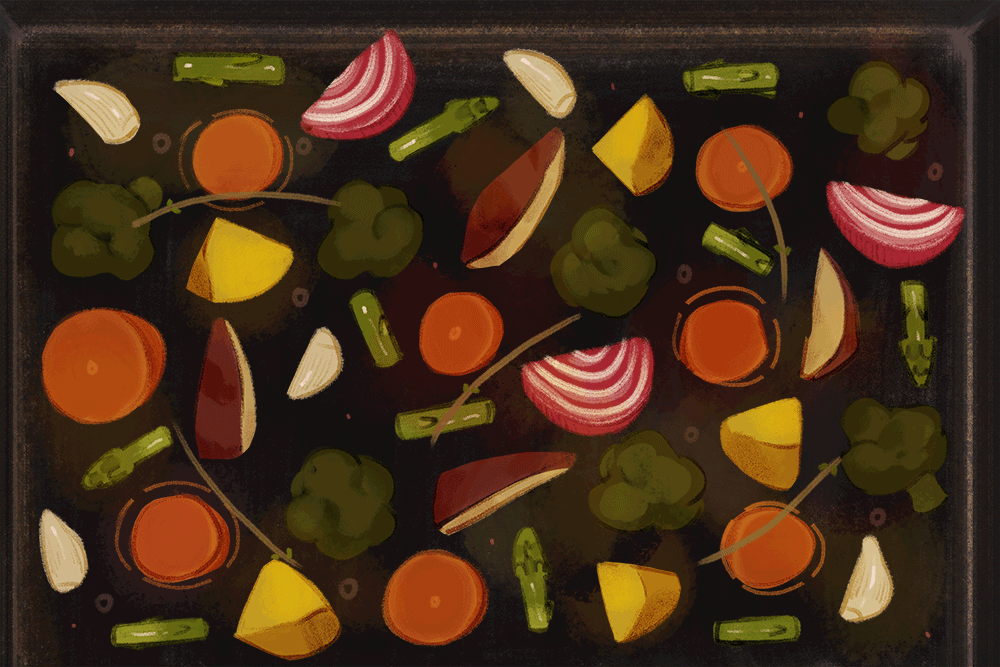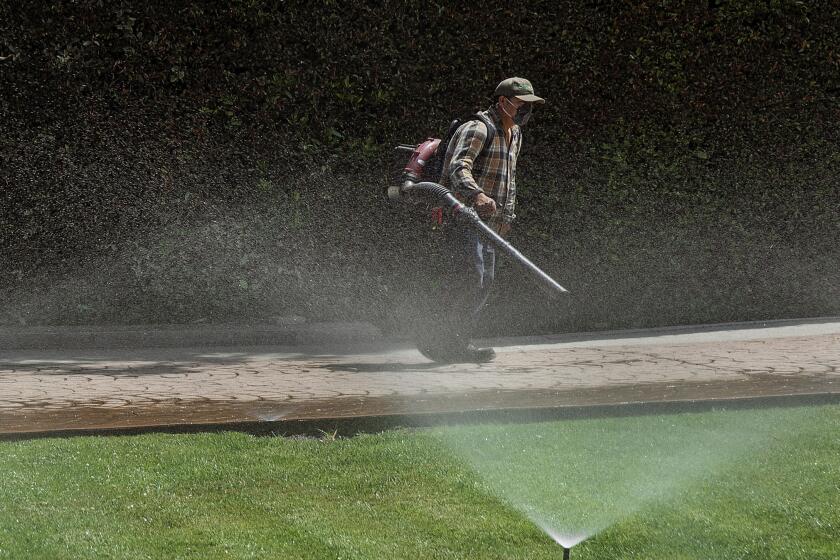Grow Your Broccoli, Dear
- Share via
I’d raised a perfect head of broccoli. It was my very first, and it was ready for the table, but I couldn’t bring myself to lop its noble head off the stalk. A few days later, still procrastinating, I suddenly grasped the fact that a head of broccoli is really a bouquet of flower buds. My perfect head was spangled with small yellow stars of blooms.
That was also the time when I absorbed the fact that picking broccoli young is crucial to good eating. You’ve heard that sugar in old-fashioned corn starts converting to starch as the ear leaves the stalk? Well, a comparable change takes place in broccoli. When left too long on the plant or kept too long in storage after harvest, sugar in broccoli turns to lignin--a material that makes up one-fourth the composition of wood! There’s nothing you can do to make lignin tender.
So whether you’re harvesting your own broccoli or choosing broccoli someone else grew, pick it young: brightly colored, buds tightly furled, and the slenderer the stem and stalks, the better. Then once you’ve brought it into your kitchen, eat it instanter.
If you haven’t yet grown a broccoli plant or two, you must. Now that you know when to harvest it, you’ll make your first harvest when you should. Your broccoli will have richer flavor and greater tenderness and sweetness than any you’ve eaten. Even if you just grow it once.
*
Unless you grow your own, you’ll never have a choice of broccoli. In addition to the supermarket sort, called heading broccoli (sometimes called Calabrese), there’s Italian sprouting broccoli.
For a number of reasons, I recommend the latter. First, it has wonderfully sweet flavor. Second, the plant has more tender stalks by its very nature than heading broccoli, because they’ve taken less time to grow to harvestable size.
And third, you’ll have a longer period of harvest. With regular broccoli, you nurture one large head, pick it, and, with the exception of straggler shoots that form on the stalk, that’s it. Sprouting broccoli forms a small central head--you cut it at three inches. After that, out pop smaller but prime shoots on the sides, lots and lots of them. If you cut them off above the point where the skin starts to toughen and two leaves are in place, a new shoot will form.
A fourth reason to grow Italian sprouting broccoli is that it’s a non-hybrid. These days, nearly every cultivar of heading broccoli in seed catalogues is a hybrid (the result of a handmade cross). They’re vigorous and uniform and some even taste good, but their seeds can’t breed true.
*
Both headings and sproutings come in green and purple. Purples are lovely in the garden but turn green in cooking. DeCicco is a favorite green sprouting broccoli and Purple Sprouting is the standard sprouting purple. Umpqua Dark Green is an exceptionally fine non-hybrid header, and Rosalind is a purple header with tolerance to heat.
Heat makes broccoli’s flowers bloom, so both types are timed to mature in cool weather. Generally, where summers are hot, sow heading broccoli in mid to late spring to harvest in autumn. Where it’s balmy in winter, you can sow seeds of sprouting sorts from late summer through winter to pick from winter through early spring. Where winters are cold, sow seeds of sprouting broccoli in early summer to eat early the following spring--sprouting is the sort most gardeners are enjoying now.
All in all, broccoli’s relatively easy. It wants full sun, rich soil and lots of water. Should aphids pounce, drown them with spritzes from the hose, then cover plants with insect-weight floating row cover (material that lets light and water in but keeps bugs out).
Unless you grow your own, you won’t have the fun of gathering humongous leaves from broccoli stalks for your soup pot. They’re the most nourishing part of the plant. Cook these leaves as you would cabbage’s. Fold the leaves in half lengthwise. If the spine is fibrous, trim it out. Slice the leaves crosswise into thin ribbons, then cook uncovered in boiling, salted water until tender. Throw in some cooked dried beans and potatoes, sauted red onions and garlic and garnish with croutons for a soup.
*
In the garden, I enjoy broccoli in a mixed border. Standing about two feet tall, as I said, there’s nobility there. Broccoli also grows well in a five-gallon container. Sprinkle seeds of pink and purple sweet alyssum around the rim for color.
Not just handsome and good eating, broccoli’s enormously valuable in terms of nourishment. You knew that. But did you know that cooked broccoli has more Vitamin C than oranges, as much calcium as milk, impressive amounts of folic acid, Vitamin A, and several other vitamins and minerals? More than that, as one of the brassicas, it’s now recognized as a preeminent cancer fighter. Saga is a heading hybrid with a superior amount of the component that detoxifies carcinogens in the body. All with negligible calories.
To cook florets and stalks so they’ll reach tenderness simultaneously, slice thick stems into pieces to match the size and shape of thin ones. To preserve color and mild flavor, cook broccoli in a single layer in an uncovered skillet in so little salted water that there’s none left by the time the broccoli’s done. To preserve nutrients, steam broccoli--but lift the lid after a couple of minutes for 10 to 15 seconds to release sulfurous compounds that would otherwise darken the green.
Cooking broccoli to the right degree takes attention. It can look bright in the water, then turn drab as it hits the bowl. Some of us enjoy broccoli tender-crisp--in fact, more crisp than tender. Others of us won’t eat broccoli unless it’s tender. When you’re cooking these splendid shoots, pay no attention to a ringing telephone or cries at your elbow. No matter what method of cooking, start tasting for doneness after four minutes, then keep testing every 30 seconds.
Back to flowering stalks. You’ll never see broccoli in bloom in the market. Although their stalks are past eating, full-blown sprays are delightful in a stir-fry or for swiping through a sauce.
See how much more there is to broccoli when you grow it?
Sources
Seeds: Umpqua Dark Green and Rosalind from Territorial Seed Company, 20 Palmer Ave., Cottage Grove, Ore. 97424. De Cicco, Saga and insect-weight floating row cover from Johnny’s Selected Seeds, Foss Hill Road, Albion, Me. 04910-9731. Purple Sprouting from the Cook’s Garden, P.O. Box 535, Londonderry, Vt. 05148.
*
We serve this broccoli with grilled fish, perhaps sea bass or shark, along with red potatoes steamed in their jackets, a relish dish of radishes and spring onions and cold Chablis to drink. To tell the truth, when it’s just the two of us, I eat two portions of broccoli and save the fish to eat cold the next day.
BROCCOLI FLORETS WITH WALNUTS, LEMON AND GARLIC
1 pound 1 1/2-inch long broccoli stalks with florets including young leaves
2 large garlic cloves, finely chopped
1/2 teaspoon salt
2 cups cool water
2 tablespoons olive oil
3 to 4 tablespoons fresh lemon juice
Scant 1 cup broken walnuts, toasted
Salt
Freshly ground white pepper
Cut apart heads of broccoli or slice between thick stalks to make stalks 1/4-inch thick.
Arrange in large, heavy skillet. Add garlic, salt and cool water. Cook uncovered over highest heat, stirring and shaking skillet occasionally, until water cooks away.
Add olive oil and lemon juice to taste. Toss to blend. Add walnuts. Season to taste with white pepper. Toss.
Cook until stems are tender but still slightly crisp, about 10 minutes. Original brightness of green will have faded slightly. Turn into heated serving bowl and serve. Makes 6 servings.
Each serving contains about:
193 calories; 219 mg sodium; 0 cholesterol; 17 grams fat; 9 grams carbohydrates; 5 grams protein; 1.77 grams fiber.
More to Read
Eat your way across L.A.
Get our weekly Tasting Notes newsletter for reviews, news and more.
You may occasionally receive promotional content from the Los Angeles Times.









